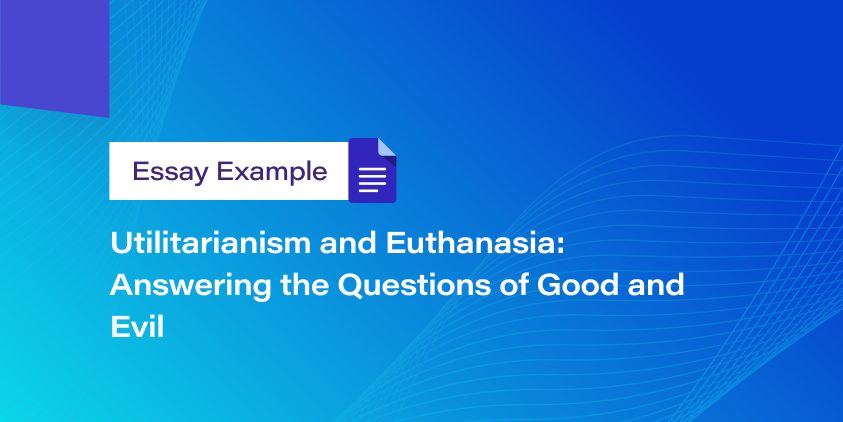Utilitarianism and Euthanasia: Answering the Questions of Good and Evil

The current social progress, development of medicine since the XX century, and the use of new technologies brought forward new socio-moral issues such as the value of life and permission of voluntary death. Euthanasia is the most disputable aspect because it makes people seek answers to questions about good and evil. In particular, issues frequently arise concerning the ability of a person to voluntarily decide about his or her life and death, whether life is an unconditional value and finally, the proper decision for the particular individual and society in general. Answers to these and other questions depend on the entire people’s community; therefore, they end up in keen disputes. Even though the issue of euthanasia has been discussed for almost thirty years, there is no single approach to it. The main reasons for such discordance of opinions are the difference in religious beliefs, philosophical directions, and cultural traditions. However, the conception of ethics, or moral philosophy, named utilitarianism, is a single approach that could stop all disputes determinately grounding Bentham’s felicific calculus.
Utilitarianism is a principle that evaluates all events, factors, and phenomena from their utility or usefulness, which is an opportunity to use them to achieve a particular aim. Therefore, in answering the question of good or evil in euthanasia, utilitarianism proposes using utility as a delimitation. However, it is significant to understand the meaning of utility for argumentation for the good of euthanasia. For example, Jeremy Bentham is one of the founders of the utilitarianism approach who formulates the basic idea of this doctrine. According to the philosopher, the greatest moral principle is maximizing happiness and supremacy over misery. Thus, Bentham claims everything to increase utility should be accepted as good.
Furthermore, under utility, he understands everything that brings joy or happiness and reduces pain or suffering. Hence, it seems obvious that euthanasia is regarded as good from the perspective of utilitarianism because the basic aim of this procedure is to reduce the unbearable pain and suffering of the individual. Moreover, utilitarianism is a theory that contradicts the idea of egoism. The possibility to commit a particular action is evaluated in each case according to its correspondence to the greater aim. In addition, while following this greater aim, an individual should think at least about personal good. Such a mindset corresponds with individual utility and should not be mixed with self-interest.
Another significant contribution of Bentham is his algorithm of felicific calculus, which is used in calculating the degree of good, and thus utility, of a particular action. In order to prove the utility of euthanasia, Bentham’s algorithm can also be used to count its good. The first point of felicific calculus is the intensity or knowledge of the good’s strength. In case an individual is suffering from an incurable, painful disease, the pleasure of its termination can be overwhelming. On the other hand, relatives of the affected will also get part of the good because they would not have to see the sufferings of their beloved ones. The second vector of the algorithm is the duration, that is, the continuity of the good. The death which follows after euthanasia is eternal. Therefore, if euthanasia is good, its outcome will last forever. The next part of felicific calculus is a certainty that good will occur. Probably, it is the most sophisticated question to answer in the case of euthanasia. The reason is that it is difficult to predict the possibility of a common good after the death of a beloved person; however, the relief is obvious for the suffering one. The next circumstance, according to Bentham, is propinquity, which shows how soon the good will happen. Euthanasia is a momentous act; therefore, its consequence in death is presupposed to occur immediately. The other two connected variables of Bentham’s algorithm are fecundity and purity. They are supposed to prove that the action will be followed by pleasure and good and not the opposite. From the position of the suffering person, the fecundity is clear; however, there are no guarantees that euthanasia will bring good to other people. Finally, the last vector of felicific calculus is the extent that means the estimation of the number of people who will be affected by the good. In the case of euthanasia, it is possible to suggest that not only related people but also society, in general, will be influenced by the action.
Overall, following the doctrine of utilitarianism, it is necessary to consider the basic arguments in favor of euthanasia. First, every individual has the right to decide what is good and evil for him or her. It is called ‘personal utility’ and should not be mixed with egotism. Everyone is up to estimate his happiness and take action to achieve it. However, one should remember that the extent of one’s own rights ends where the rights of others begin. Euthanasia is a procedure to stop personal suffering and misery; therefore, personal utility is obvious. Every human has the right to a decent life, which includes the right to free self-determination, to choose fate, to be protected from ineffective and inhumane treatment, and to preserve human dignity, which may be essential to the existence itself, and the right to death itself. The loss of human dignity is worse than death. In addition, acceptance of the right of a person to death does not posture any danger to society. The reason is that it involves the area of individual freedom that is not affected by public regulation. A sidelong statement in favor of the fact that an individual is autonomous in disposing of his or her life is a denotation of the right of a person to put his/her life at mortal risk, for example, by accomplishing his/her professional duties.
Second, life is good only when joy predominates over suffering and positive feelings over negative ones. This statement is most evident in confirmation of the legalization of euthanasia, particularly when life is full of insufferable pain without hope for indemnity, and there is a clearly expressed request of the patient to end suffering. The other argument is that the maintenance of life at the stage of dying through complex technologies is extremely financially costly. The funds spent on preserving the hopelessly ill could be used to treat patients with a chance of recovery, proving the common utility. Finally, the need to reduce the number of disabled, especially newborns, is motivated by biological factors. It presupposes the concern for safeguarding against the threat of degeneration of the human race due to the accumulation of pathological genes in the population.
Conclusion
It should be noted that, unlike other human beings, a person can realize his/her mortality. In addition, for individuals, death appears not as a natural but as a socially significant phenomenon in the complex context of social relations. Grounding on Bentham’s felicific calculus and the conception of utilitarianism, the human does not deal with death as a biological phenomenon but rather with an attitude toward it that is the expression of a certain value position. Death as a value concept presupposes the existence of another evaluated object: life. The criterion of evaluation is the conception of understanding good and evil. As was previously stated, life is not always good, and death is not always evil. Life is good only when brought to a certain standard, particularly when it is filled with certain basic goods. When these basic goods are unavailable, death can become the prevailing good for a person. Due to consideration of the basic provisions of utilitarianism, it becomes evident that the methodological function of the utility principle was insufficient to assess euthanasia. However, when limiting its scope, it can have a positive effect. It means that the utility principle should be considered as one of the factors that, along with others, make it possible to evaluate the act comprehensively.
Overall, utilitarianism supports the idea of euthanasia guided by evaluating the effect that its application will achieve. However, the prohibition or resolution of euthanasia will not be the most humane solution to the problem. On the contrary, an active struggle against any manifestations of passivity in everything relating to a human, assistance to the cause of life, support of meaningful joyful life, which brings happiness, and sanction of death in case the life is no more personal good are the factors that can assist in evaluating the benefits and the disadvantages of euthanasia.
📎 References:
1. Alacevich, Michele, and Anna Soci. “The Long Neglect of Inequality.” Inequality: A Short History, Brookings Institution Press, 2017, pp. 29–52.
2. Dimmock, Mark, and Andrew Fisher. “Utilitarianism.” Ethics for A-Level. 1st ed., Open Book Publishers, 2017, pp. 11–29.
3. Gollier, Christian. “Choice and Measure of Values.” Ethical Asset Valuation and the Good Society, Columbia University Press, 2017, pp. 23–70.
4. Kreide, Regina. “The Theory of Justice.” The Habermas Handbook, edited by Hauke Brunkhorst, Regina Kreide, and Cristina Lafont, Columbia University Press, 2017, pp. 162–9.
5. Murray, Malcolm. “Euthanasia: End-of-Life Choices.” Morals and Consent: Contractarian Solutions to Ethical Woes, McGill-Queen’s University Press, 2017, pp. 67–85.
6. Heck, Patrick R., and Joachim I. Krueger. “Rational Healing.” The American Journal of Psychology, vol. 130, no. 4, 2017, pp. 523–6. https://www.jstor.org/stable/10.5406/amerjpsyc.130.4.fm.
